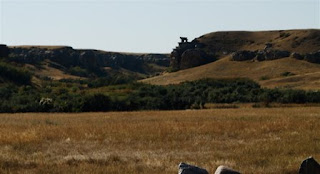Writing about the pictures and hoodoos at Writing on Stone, is in a word, ironic. I have been trained to show, not tell. We decided to visit Southern Alberta late last week. It was still hot outside (45 degrees Celcius in the coulees) and a blizzard could arrive any time.
I was amazed by the immediate sense of serenity as we walked the ridge to the visitor centre. Writing on Stone is one of numerous Alberta sacred sites. Many nations have converged for centuries, on the banks of the gently winding Milk River.
Limestone rocks provide shelter. The river feeds a valley oasis and provides alternative transportation. Portions of the area were also used as burial grounds. One of the most intriguing practices, to me and Jen, was that burial rights included placing the dead in high ledges amongst the cliffs, or in the tops of trees.
While Writing on Stone facilitated life and death transitions, it also became an ancient library of said rights and passages (including vision quests). It was humbling to see images older than accepted history, still telling tales. I wondered a few times, if my work would last 100 years with current data storage issues...never mind up to 100 centuries!
In a few skillful strokes, ancient peoples communicated clear lifestyle information we can study to present day. The Petroglyph (below), was located much higher on the cliff face, than other scenes. Thus indicating higher water levels (at one time) and erosion in the Milk River valley...or the use of a rope and harness to repel down the cliff to create.
As we toured the ancient petroglyph sites, our guide made great arguments for the import of visual communication. She discussed defacement of the stone art. "Modern" etching is considered grafitti, rather than a contribution to human history, because it is pointless to future study. Or is it? We don't know what future scholars (if there are any) will value.
She did however highlight inefficiencies of initial carving, where many lines are required to scribble "So-and-So wuz here, 1974". Aside from being a crude attempt at immortality...if English is a living language in five to ten thousand years (doubtful), our guide stated, initials tell us nothing about S0-and-So.
We'll never know what his/her shelter, food, tools, transportation, dress or behaviour was like. But, I ask, could this be the point? So-and-So may have had nothing good to say about a possible uprooted and disenchanting life. Or he/she may have been uneducated as to the value of ancient communication or very academic, with the thought rock art was passe.
Michelangelo (and many others) would disagree. We will never know actual motivation behind people's actions, many times they don't even know. To an artist, initial could amount to the equivalent of carved baby-talk, but charming as a ditty from a lover on a moonlit solstice evening... Merit is determined by cultural/personal values at any given time.
I admit a preference for stylized prairie scenes, to messy chicken scratch. Foresight, which would have helped preserve some of the stone work, is something elders pass on. Pioneer generations did not have access to such wisdom. Their elders remained in Europe. Settlers relocated based on false advertising and youthful zest, without the means to return home or birth control.
Sacred sites and liminal zones, provide rich opportunities for increased understanding. I saw a symbolic culture clash, recorded in timeless media. One side not being respected, the other not respecting themselves...How can you give something, you don't have?
As people go within to work and reflect, healing of great magnitude is occuring. None are to blame for ignorance and all have a divine light within. When you know better, do better.
The beautiful petroglyphs we saw depicted; fighting or birthing techniques, clothing changes, representations of historical boundary loss (between Alberta and Montana) and the clear value of horses in this valley.
Writing on Stone is an english name, and perhaps clumsy translation, taken from the aboriginal Aisinai'pi, meaning "It is Pictured/Written". You can get more information at - http://whc.unesco.org/en/tentativelists/1935/ as well as many sites through your friendly search engines.
Without further ado (er' scribbles of my own):
Sweetgrass Hills as seen from Alberta - 9/26/2009
Bunny in the Rocks - 9/26/2009
Table Rock - 9/26/2009
Square Shoulder Man - 9/26/2009
Deer at play - 9/26/2009
One of the Rock Spirits - 9/26/2009
Hoodoos and Sweetgrass Hills - 9/26/2009
Framing with an organic Tripod - 9/26/2009
Reframing... - 9/26/2009
The bolt on my tripod sheered off a few weeks ago...in true spirit of the valley, nature provided for all of our needs!
Website Shot - 9/26/2009
Meditation Time - 9/26/2009
Milk River S-Curve - 9/26/2009
And the Antelope Play... - 9/26/2009
I see a half moon a risin' - 9/26/2009
If you have the opportunity, this site is worth the visit. I'd like a camp-out under the stars next time. It's said to be a lovely observatory!
















No comments:
Post a Comment